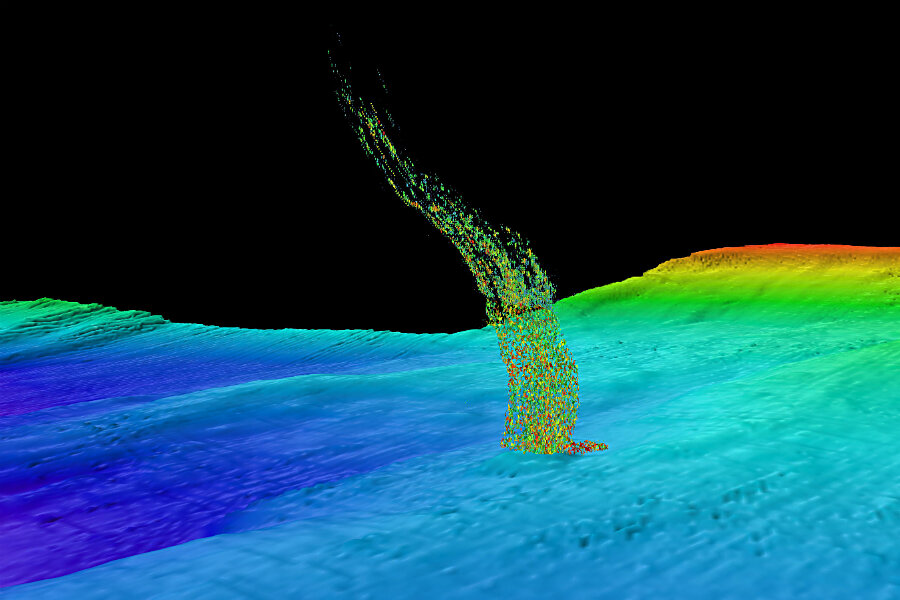Climate change: Why methane gas is leaking from the ocean floor
Loading...
Giant plumes of methane gas appear to be bubbling up off the Pacific Northwest coast.
This is according to a new study which suggests warming ocean temperatures a third of a mile below the surface are causing the bubbles.
The new research by the University of Washington shows that, of 168 bubble plumes monitored within the last 10 years, a large number of plumes were seen at a depth considered “critical,” for the stability of methane hydrate. .
"We see an unusually high number of bubble plumes at the depth where methane hydrate would decompose if seawater has warmed,' said lead author H. Paul Johnson, a University of Washington professor of oceanography.
'So it is not likely to be just emitted from the sediments; this appears to be coming from the decomposition of methane that has been frozen for thousands of years.'
In recent months the US government has put in place measures to reduce methane emissions in an effort to combat climate change. Methane is the second most prevalent greenhouse gas emitted in the US from human activities, so cutting emissions of the gas is an important part of fighting climate change.
In 2013, methane accounted for about 10 percent of all US greenhouse gas emissions from human activities according to EPA. Although there’s much less methane in the atmosphere, the gas is 23 times more potent than carbon dioxide in trapping heat in the atmosphere.
In August, the Obama administration proposed measures meant to reduce methane emissions over the next 10 years as part of the broad effort by the government to reduce greenhouse gas emissions by 26 to 28 percent by 2025.
The Christian Science Monitor reported at the time of the announcement,
The proposed rules require that oil and gas firms find and repair natural gas leaks throughout the oil and gas production and transportation chain. They also require that energy firms capture associated methane emissions from hydraulically fractured oil wells and limit emissions from equipment used in the storing and transporting of natural gas.
By 2025, the rules would reduce 340,000 to 400,000 short tons of methane, according to EPA. That's roughly the same as reducing 7.7 million to 9 million metric tons of carbon dioxide. EPA projects the benefits of reducing methane and related emissions will total between $460 million and $550 million by 2025, outweighing the expected costs of between $320 million and $420 million.
Earlier this year, the White House said that it would reduce methane pollution by 40 to 45 percent by 2025 drawing praise from some environmental groups for the crackdown on methane.
But others saw the rule as a good start but inadequate.
“Setting the first national standards for methane emissions from the oil and gas industry is an important move, but it can’t be the last," Fred Krupp, president of Environmental Defense Fund, said in a statement. "This proposal addresses methane emissions from newly built and modified oil and gas operations, but not from the existing facilities that account for all of today's emissions and will still account for 90 percent of the problem by 2018."
Methane is emitted from natural sources such as wetlands, as well as human activities such as leakage from natural gas systems and the raising of livestock. Last year, scientists discovered a methane hotspot in the Southwest Four Corners region, where Arizona, New Mexico, Colorado, and Utah intersect. At the time, The Christian Science Monitor reported:
Methane leaks naturally from gas formations around the world, and without a detailed historical baseline of emissions from a particular area it can be hard to determine how responsible industry is for methane emissions in certain areas, according to Terry Engelder, a professor of geosciences at Pennsylvania State University in State College.
"There is no baseline in the Four Corners region," Professor Engelder said in an e-mail. "Therefore, we really don't know to the extent to which the coal industry and coalbed methane increased and aggravated an existing, natural condition."
The new University of Washington study claims warming oceans maybe a potential bigger source of methane released into the atmosphere than man-made releases.





